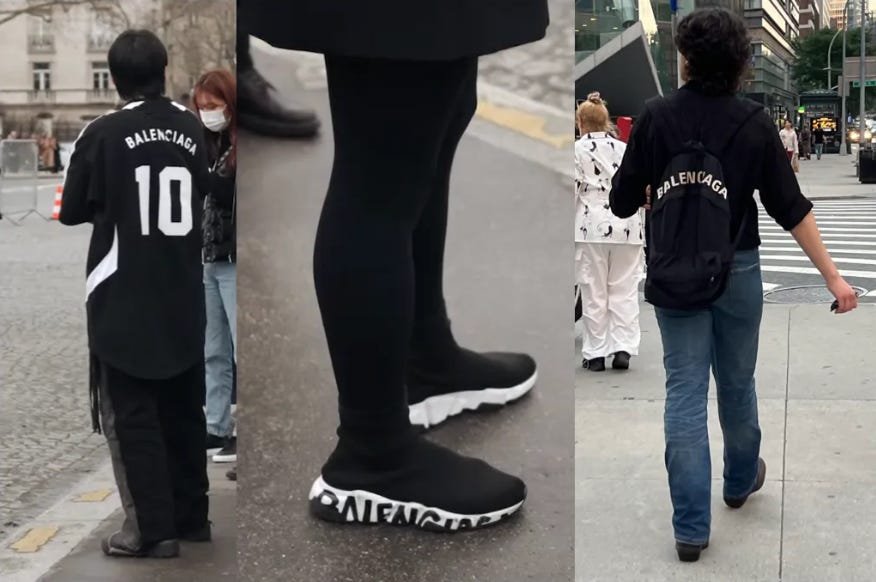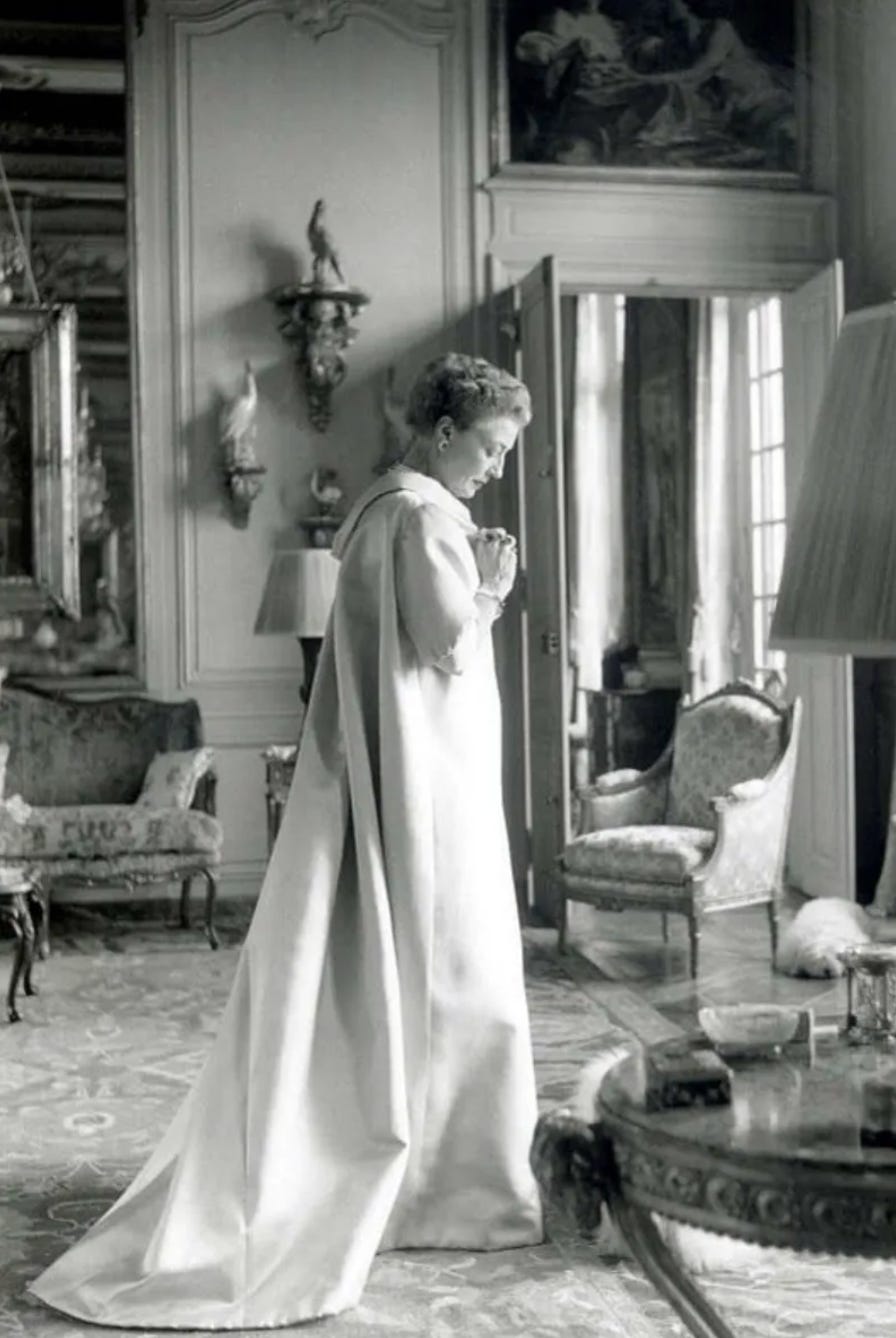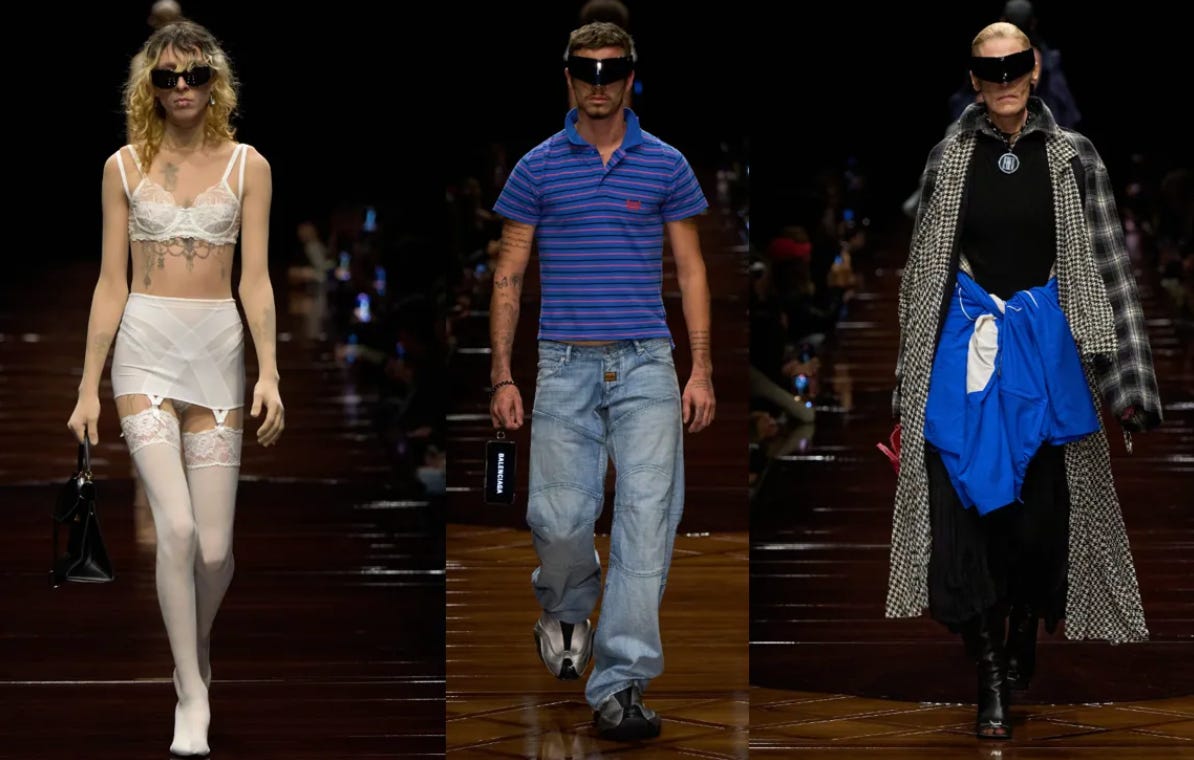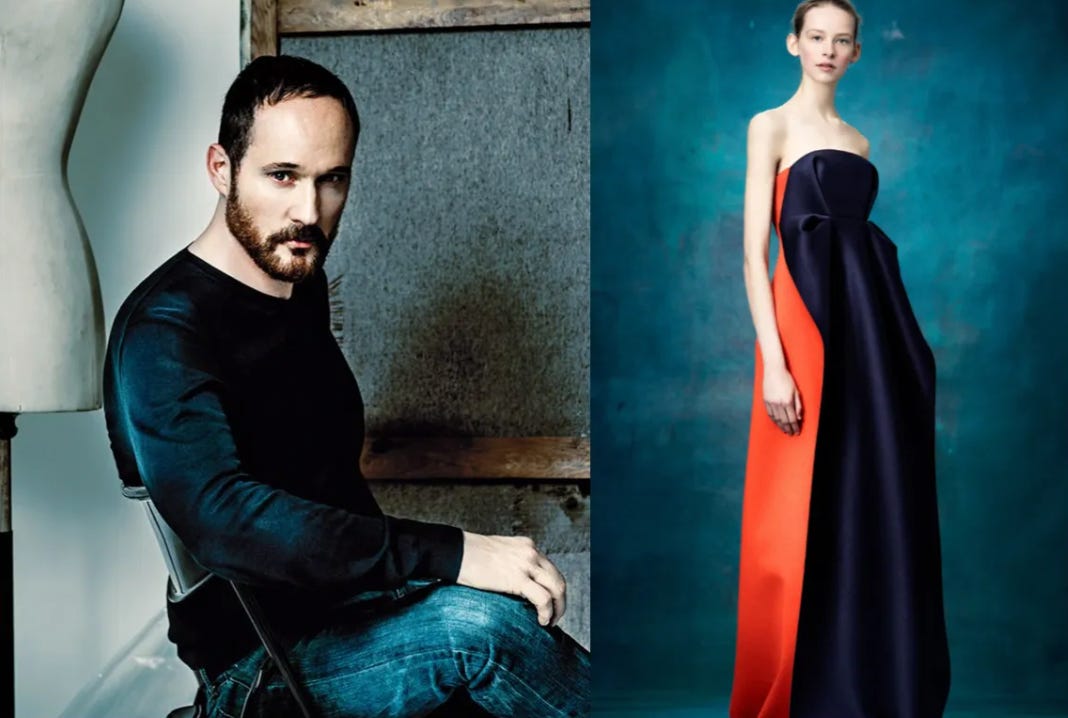*Please click on the title to see this post in its entirety.
It was announced on March 13th that Demna (formerly known as Dema Gvasalia, he dropped his surname in 2021) will leave Balenciaga for Gucci after his final couture show this July. In the months since that announcement, it’s been surprisingly quiet. Pieter Mulier, of Alaïa, and Daniel Roseberry, of Schiaparelli, have been rumored as possible successors. Both seem like lateral moves, contributing to the now established paradigm of designer musical chairs.
Kering is in trouble; just look at the precipitous dip in stock prices. Instead of following the usual playbook, perhaps it’s time to do something shocking like restore the original intent and integrity to the house that Cristobal Balenciaga built. I know I sound old and farty when I say this, but hear me out. Integrity seems to be lacking in the giant, conglomerate-owned design houses lately. They’ve become giant money-making machines and household names for heavily branded, ordinary items. On top of the lack of innovation, prices have outpaced already high inflation. Me thinks the jig is up. There are exceptions, but as a whole, making luxurious, innovative clothes has lost its importance to sales of handbags, perfume, and branded basics.
Take Gucci, for instance, for all their changes of designers over the years, with a hot streak during the Alessandro Michele years, they still rely mainly on the codes of the house in place since the 1960s: the Jackie bag and the horsebit loafer. I’ve always loved the Jackie bag and occasionally go to Gucci to check them out. Just this week, a Gucci sales associate showed me the medium Jackie bag in pebble leather. Confused by the diminutive size, I asked, isn’t this the small size? No exaggeration, in a whisper, she told me they were told about a month ago that that’s not the “verbiage” they are to use. The medium is now the large, and the small is now the medium. Why I have to wonder would they purposefully gaslight their customers? The now medium bag can only be described as large enough for a phone, wallet, lipstick, comb, and little else. Right then and there, I decided that if I ever get my Jackie bag, it will be vintage. Also, the feel of the bag didn’t scream luxury, warranting the price. It was nicely made but not exceptional. A $500 bag is just as well made. My point is, where's the integrity? By changing the sizes, they found a way to increase the price without just increasing the price, but they are taking their customers for fools.
Christobal Balenciaga was an artist and innovator. His most advanced work was made in the 1960s, just as prêt à porter was beginning to dominate fashion. He refused lucrative offers to start his own prêt-à-porter line, stating, “I shall never prostitute my art.” He closed his couture house in 1968. Fashion could use that kind of integrity now.
I believe Kering has an opportunity to restore Balenciaga to the preeminent couture house it once was. That would truly set them apart. While everyone else is chasing the Coachella crowd, Balenciaga should be shooting for chic European royals like Beatrice Borromeo and true couture customers who wear such clothes.
In honor of the man and the uncertainty surrounding the house that bears his name, I’m reposting my story on the past, present, and possible future of Balenciaga. While I’m in Spain, I hope to visit the Balenciaga Museum, though it’s a full five-hour drive from where I’ll be, it would be worth it to pay homage to the master in the tranquil corner of Spain where it all began.
Years ago, a sales professional from Saks revealed to me that many heritage designer brands banked on teens and twenty-somethings who bought Balenciaga, Givenchy, and Gucci without any knowledge of the namesakes of the houses. They wanted the clout of the branded hoodies, sweatshirts, and trainers. I was floored by this. First, that they bought for a name of which they knew nothing, and second, that price was not a deterrent in the least. No house has capitalized on this more than Balenciaga.
At what point will the novelty of the $1400 designer hoody lose its appeal? Lagging sales at Balenciaga suggest it has already. The falling stock prices for Kering are not my concern. What does matter to me is the Balenciaga name. Can the integrity of what Cristóbal Balenciaga represented be restored to the house? I know I’m not alone in my admiration for the master. The designer, Ralph Rucci, posted a Balenciaga runway look consisting of baggy jeans, trainers and a striped polo with a lengthy caption, ending with “WAKE THE FUCK UP”. You get the idea.
I’ve worshipped Cristóbal Balenciaga since I learned about him as a design student. Christian Dior famously referred to Balenciaga as “the master of us all”. Coco Chanel called him, “The only couturier in the truest sense of the word, the others are simply fashion designers”. His creations are displayed in museums around the world. I’m not exaggerating when I say one of my most memorable moments in a museum occurred in a medieval chapel within The Cloisters in upper Manhattan. There, a 1967 Balenciaga wedding gown was displayed to maximum effect as part of the Heavenly Bodies show.
The Early Years
Balenciaga was born on January 21, 1895, in the small fishing village of Guetaria, in the Basque province of northern Spain. His father, a sailor and mayor of the village, died young, leaving behind a wife and three children. Balenciaga’s mother supported the family by teaching dressmaking to girls in the village. Through this early exposure, Balenciaga discovered his passion and natural aptitude for the craft. At the age of twelve, he worked as an apprentice for a tailor in nearby San Sebastián. At thirteen, Balenciaga approached an elegant woman he observed and asked if she would let him design an outfit for her. “Why would you want to do that?” she asked. “Because I think I could” was his response. That fateful exchange with the Marquesa de Casa Torrés set Balenciaga on the path to his destiny. There is no record of that first attempt, but he continued to work for the Marquesa and was permitted access to her wardrobe and trusted to copy dresses for her.
Balenciaga opened his first couture house in San Sebastián in 1919. Throughout the twenties and thirties he opened additional shops in Madrid and Barcelona. The Civil War in Spain eventually forced Balenciaga to move to Paris. In August of 1937 he showed his first Parisian collection. Despite his notoriety in Spain, the press took little note. Sales however were brisk, and the first collection was a commercial success. Word quickly spread and within a year the house was firmly established.
The Paris Years
Throughout the forties and fifties, Balenciaga reigned as the undisputed master of couture. He had the respect and friendship of his contemporaries, including Chanel, Givenchy, and Vionnet. During World War II, the house continued to operate throughout the German occupation of Paris. Due to gas rationing, loyal clients would cycle to fittings and carry their bikes up the three floors to the atelier.
Despite his policy of denying interviews and photographs of himself, the press treated him with reverence, adding to his mystique and dominance in fashion. By the mid-sixties, however, a seismic shift was taking place. The rise of Courrèges, a former employee, fueled by miniskirts, futuristic fashion, and a youth-obsessed culture, changed fashion. The praise once lavished on all Balenciaga collections had cooled considerably as the importance of the couture waned with the advent of prêt-à-porter. Undeterred, Balenciaga continued his artistic pursuit of purity of form.
The End of an Era
In May of 1968, after years of dwindling sales, the house of Cristóbal Balenciaga closed its doors. Many of his longtime clients were devastated, Diana Vreeland and Mona von Bismarck among them. Von Bismarck was reported to have been so distraught by the news that she took to her bed for three days. It was the end of an era. Decades later, by benefit of hindsight, the world came to realize that during the sixties, Balenciaga achieved what his entire career was leading to: purity of form. In these late career masterpieces, the entirety of his genius coalesced.
Balenciaga Now
For the Spring ’25 Balenciaga show, Demna Gvasalia presented some new ideas, such as the seemingly modest dresses in front, heavily laced in the back. For the show, they exposed slices of skin, but commercially, as demonstrated by brand ambassador Nicole Kidman, a more modest alternative is possible.
The majority of the show, however, relied on old standbys: oversized bombers, low-slung baggy jeans, giant shoulders, and the in-your-face ugly aesthetic Demna is known for. There were new ideas, but ideas are easy. Fully developed ideas, well executed, contributing to a cohesive whole, are not. It’s time that distinction is made. Demna is not the enfant terrible he was nearly ten years ago, nor has he sufficiently evolved. I believe he’s a talented designer with original ideas, but he seems to have become complacent. His skill set, I believe, is far better suited to Gucci. I hope that he will come up with a new playbook for his new role and not rely so heavily on being a provocateur, and instead focus on making great clothes and accessories. Perhaps he could even pull fashion out of the rut it’s been stuck in.
The Future of Balenciaga
As a heritage brand, Balenciaga should stand out for its unique history as a house of integrity and excellence. I believe that Kering could better capitalize on this by leaning into its couture roots and paying homage to the creative genius of Balenciaga by hiring a designer cut from the same cloth. Pier Paolo Piccioli understands modern luxury without being mired in the past. Another brilliant designer is Josep Font; his work at Delpozo was outstanding. The parallels between Font and Balenciaga are pronounced, further emphasized because he is also Spanish. It’s time the house of Balenciaga reclaimed its place as the leader in luxury. That would be real news.
What are your thoughts on the subject? Leave a comment and share this post with a friend. As always, thank you for reading and supporting my work by subscribing. My next post will be from Spain!
You can see my vacation edit here
See my Prada edit here
See my transition jacket edit here and suede Jacket edit here
See my spring/summer sweater and tees edit here
xxx Jolain



















"They wanted the clout of the branded hoodies, sweatshirts, and trainers." Never really got that trend although when I was a youngster we definitely wanted genuine Levi jeans or jackets with the leather logo. Clothes with the maker's name seems a tad unsubtle but maybe that's the point. " Look at me, I've got shed loads of money so can afford to dress with zero taste". Loved your description of the Jackie bag with its changing size descriptors. Not unlike supermarket descriptions of economy and jumbo sizes. Thanks for the read. Hope you're enjoying your Spanish trip.
This is such a delightfully diplomatic take on what has happened to Balenciaga. Especially when you consider what the Master himself would have said.